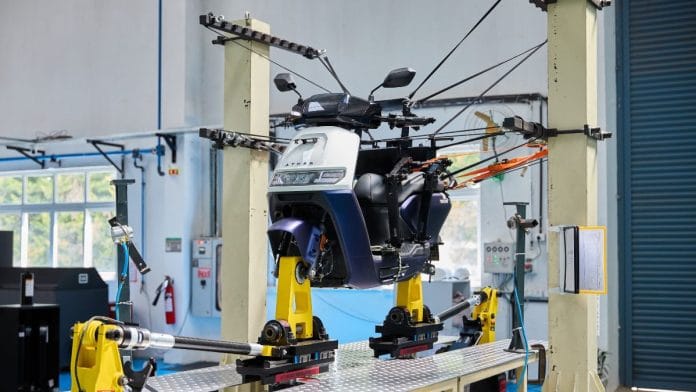A nondescript warehouse on the outskirts of Bengaluru hides quite a secret inside. A machine shakes an electric scooter to the point of destruction. It is loud, as the machine rattles and jolts the two-wheeler secured in place, while also mimicking the weight of a real rider and pillion. It runs for 15 days non-stop, simulating the service life of the scooter—1,00,000 kilometers or ten years.
This is Indian electric two-wheeler startup Ather Energy’s expanded Product Testing & Validation Centre, which Swapnil Jain, co-founder and CTO of Ather Energy, has christened ‘The Juggernaut’. And the electric scooter being tested to near-destruction, Jain said, must work flawlessly once it is taken off the rig. “We see if it starts and rides properly. If it doesn’t, that is where we know we have a problem.”
This is not the only rig in this space. The nearly 40,000–square–foot facility has simulators for all scenarios that a vehicle normally experiences in real life—water ingestion, dust, and extreme temperatures. “We try to cover 98 per cent of all possible usage scenarios over here. And we are always learning, because this is in addition to the several scooters that we send out for testing across the country from Ladakh to Kerala, and we are learning new situations from them and adapting those into the testing cycle over here, Jain said.
Ather Energy had added one more test after the heavy rainfall in Bengaluru last year when several scooters got stuck in flooded basements. “The battery stays underwater for a few hours and should work afterwards, not just work once or twice but through thousands of charging and discharging cycles,” Jain told me.
Upending automobile industry
What else I found fascinating was Ather’s small test track. It has nothing fancy compared to advanced tracks, but features some ‘real-world’ Indian tweaks.
These include small concrete mountains disguised as speed breakers found all across India, a few really deep potholes, and, strangely, a pavement drop. It might not be legal, but across India, two-wheeler riders occupy pavements and often have to drop down six-eight inches. “Is it right? No, but it happens and we have to test for it because we are building scooters for India,” said Jain.
Ather Energy has spent a large sum of money on the new centre not just to test its products in extreme conditions, but also to manufacture them faster. For Tarun Mehta, CEO and co-founder, Ather Energy, it is “like software testing but for hardware”.
“The idea is to find the faults or find improvements that can be made, it could be incremental improvements to the manufacturing process not just the product but at a rapid pace,” he said.
But this rapid rate of development has completely upended the automotive industry. Earlier, products used to be developed over years and components, including engines, stayed the same for generations, even decades. But, today, the manufacturing of two- and four-wheelers has become akin to that of consumer electronics, like smartphones. Think of it like a new mobile with an updated camera software that will also work on some older phones, provided they are just a couple of generations old.
Also read: Hyundai, Maruti, Nissan—sales are down at home, but ‘Made in India’ exports are driving growth
Using AI, data points
Mehta sees this as a challenge for both new and old automotive companies. “We try to ensure a degree of backward compatibility with each iteration of our product, so any new feature that we add can work on older products. But I think that is the challenge for us as a manufacturer, to make sure that we keep offering new features to existing users as well”.
He added that when Ather launched the auto hold feature in 2023, which prevents the scooter from rolling away, it was backward compatible with some older products, but not with the oldest gen-1 scooters.
But in this changing world, rapid technology advancement has become a reality of modern life. The rate of development of automobiles is truly mind-boggling. Both the co-founders of Ather highlighted how artificial intelligence and collecting millions of data points every day from nearly four lakh Ather scooters on roads are allowing for these crunched development cycles. And this is the reality that even I as an automotive journalist have to face. A few lines of code could transform a product more than a new suspension system. That does seem painful.
@kushanmitra is an automotive journalist based in New Delhi. Views are personal.







I am waiting for a disruptor in the form of an electric scooter with a range of 250 km carrying a price tag of 80 grand on road.